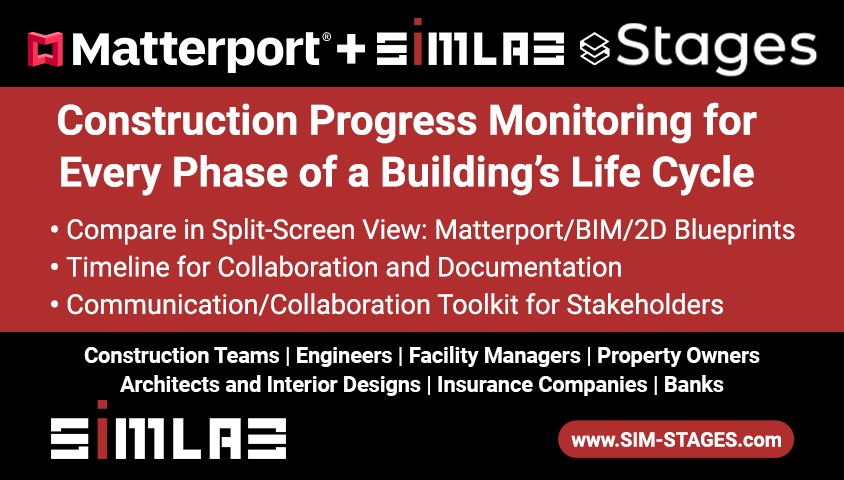WGAN-TV Podcast: "Using a Matterport Pro3 to Scan a Baseball Stadium"18518
Pages:
1
 WGAN Forum WGAN ForumFounder & WGAN-TV Podcast Host Atlanta, Georgia |
DanSmigrod private msg quote post Address this user | |
WGAN-TV | Tom Sparks (Sparks Media Group): “What I Learned from Using a Matterport Pro3 Camera to Scan a Baseball Stadium” | Guest: Scan Your Space (a Division of Sparks Media Group) Founder and CEO Tom Sparks | Episode: 183 | Thursday, 30 March 2023 | www.ScanYourSpace.com | www.SparksMediaGroup.com | @ScanYourSpace WGAN-TV Podcast | WGAN Forum Podcast 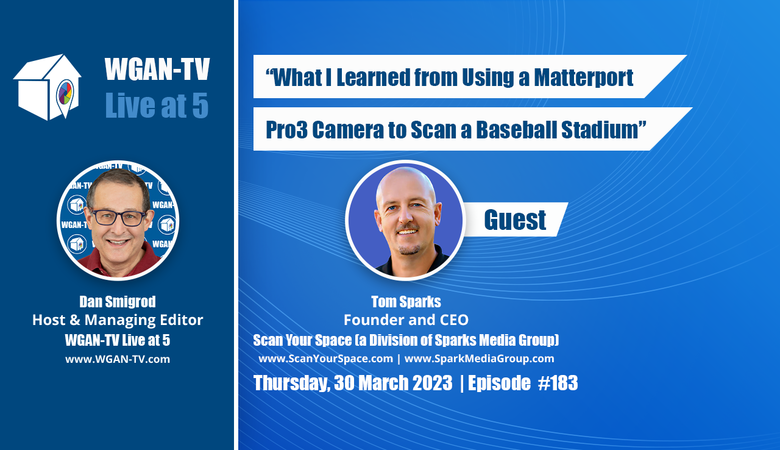 WGAN-TV Podcast | Tom Sparks (Sparks Media Group): “What I Learned from Using a Matterport Pro3 Camera to Scan a Baseball Stadium” | Guest: Scan Your Space (a Division of Sparks Media Group) Founder and CEO Tom Sparks | Episode: 183 | Thursday, 30 March 2023 | www.ScanYourSpace.com | www.SparksMediaGroup.com | @ScanYourSpace WGAN-TV Podcast | Tom Sparks (Sparks Media Group): “What I Learned from Using a Matterport Pro3 Camera to Scan a Baseball Stadium” | Guest: Scan Your Space (a Division of Sparks Media Group) Founder and CEO Tom Sparks | Episode: 183 | Thursday, 30 March 2023 | www.ScanYourSpace.com | www.SparksMediaGroup.com | @ScanYourSpace WGAN Forum Podcast | Tom Sparks (Sparks Media Group): “What I Learned from Using a Matterport Pro3 Camera to Scan a Baseball Stadium” | Guest: Scan Your Space (a Division of Sparks Media Group) Founder and CEO Tom Sparks | Episode: 183 | Thursday, 30 March 2023 | www.ScanYourSpace.com | www.SparksMediaGroup.com | @ScanYourSpace WGAN-TV eBook | Tom Sparks (Sparks Media Group): “What I Learned from Using a Matterport Pro3 Camera to Scan a Baseball Stadium” | Guest: [url=https://scanyourspace.com/]Scan Your Space (a Division of Sparks Media Group) Founder and CEO Tom Sparks | Episode: 183 | Thursday, 30 March 2023 | www.ScanYourSpace.com | www.SparksMediaGroup.com | @ScanYourSpace  WGAN-TV Training U  WGAN-TV Training U (in Matterport) | Tom Sparks (Sparks Media Group): “What I Learned from Using a Matterport Pro3 Camera to Scan a Baseball Stadium” | Guest: Scan Your Space (a Division of Sparks Media Group) Founder and CEO Tom Sparks | Episode: 183 | Thursday, 30 March 2023 | www.ScanYourSpace.com | www.SparksMediaGroup.com | @ScanYourSpace WGAN-TV | Tom Sparks (Sparks Media Group): “What I Learned from Using a Matterport Pro3 Camera to Scan a Baseball Stadium” | Guest: Scan Your Space (a Division of Sparks Media Group) Founder and CEO Tom Sparks | Episode: 183 | Thursday, 30 March 2023 | www.ScanYourSpace.com | www.SparksMediaGroup.com | @ScanYourSpace Quote: Originally Posted by ScanYourSpace Tom @ScanYourSpace Thanks for also sharing your video (above) with the WGAN Forum community. Dan WGAN-TV Podcast: Tom Sparks (Sparks Media Group): “What I Learned from Using a Matterport Pro3 Camera to Scan a Baseball Stadium” Hi All, [WGAN-TV Podcast above ... eBook above ... Transcript below ...] -- What are some of the possible uses of a Matterport digital twin of a baseball stadium? -- If you 'pitch' a baseball park, what are some of the ways that you might charge? -- What are some of the hardest things about scanning a baseball stadium? Find out the answers to these questions - and many more - on WGAN-TV Live at 5 on Thursday, March 30, 2023 when my guest will be Scan Your Space (a Division of Sparks Media Group) Founder and CEO Tom Sparks for the topic: ✓ WGAN-TV | "What I Learned from Using a Matterport Pro3 Camera to Scan a Baseball Stadium" Here are some of the questions that I anticipate asking Tom during the show: 1. What are possible use cases for scanning a baseball stadium? 2. How would you charge a client to do this work (hourly, day rate, flat rate)? 3. Aside from the Matterport Pro3 Camera, what supporting equipment did you have? 4. What were some of the expected challenges you encountered? 5. What were some of the unexpected challenges you encountered? 6. Did you have any alignment issues, if so how did you overcome them? 7. What was the easiest part of this job? 8. What was the hardest part of this job? 9. What was the feedback from the client about the work you turned in? Other questions that I should ask Tom during this WGAN-TV Live at 5 show? Best, Dan P.S. Have you scanned a baseball stadium with a Matterport Pro3 Camera? What have you learned from that experience? --- 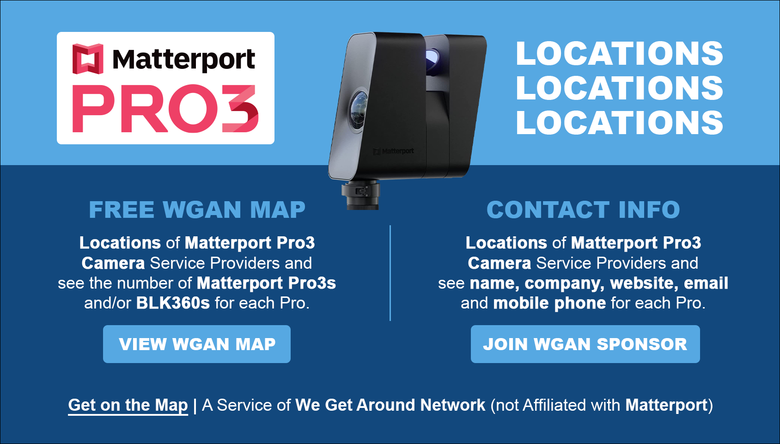 Get on the WGAN Map | View WGAN Map | Join WGAN Sponsor 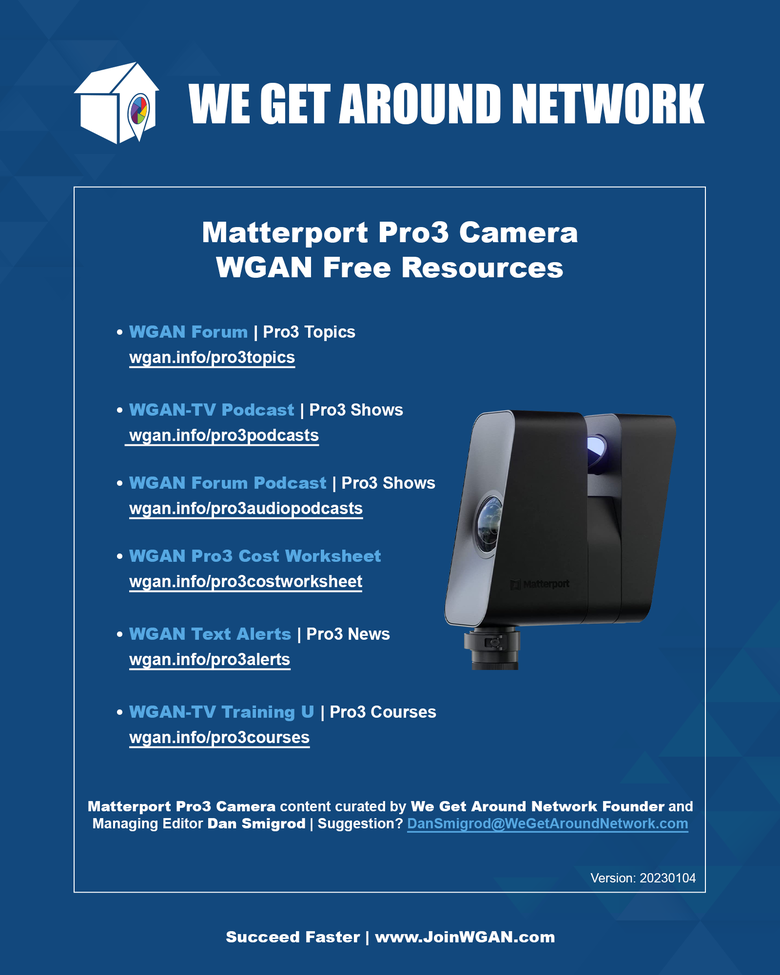  WGAN.INFO/pro3alerts | www.JoinWGAN.com | Text pro3alerts to 877-805-0960 | powered by texting platform: www.SimpleTexting.com 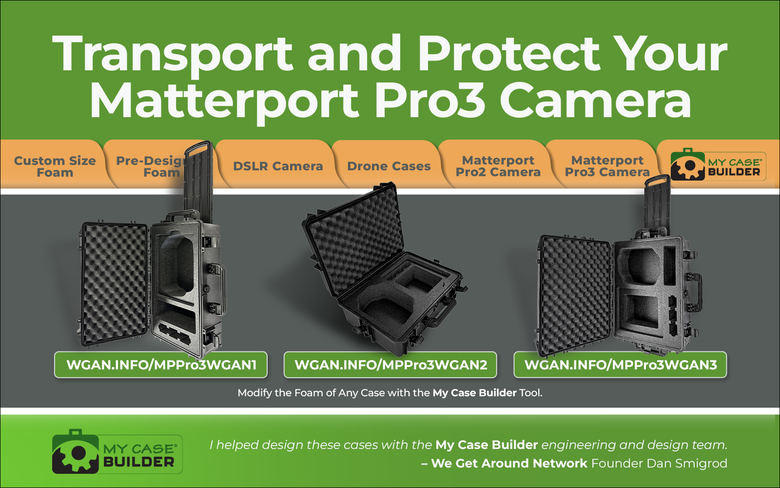 ► Small ($219.99) | WGAN.INFO/MPPro3WGAN1 (Master D2011-7 Case) (wheels) ► Medium ($194.99) | WGAN.INFO/MPPro3WGAN2 (Expert D1913-7 Case) (no wheels) ► Large ($264.99) | WGAN.INFO/MPPro3WGAN3 (Maestro D2116-7 Case) (wheels, more storage)  Use this We Get Around Network (WGAN) affiliate link to buy any hard case from WGAN.INFO/MyCaseBuilder and receive - free - 12 Months WGAN-TV Training U in Matterport.  Use this We Get Around Network (WGAN) affiliate link to buy a Matterport Pro3 Camera via Amazon - WGAN.INFO/Amazon-300 - and receive - free - 12 Months WGAN-TV Training U in Matterport.  WGAN-TV Podcast Play List: Pro3 | WGAN Forum Playlist: Pro3  WGAN Forum Discussion: WGAN Cheat Sheet: Cost Worksheet for Matterport Pro3 Camera 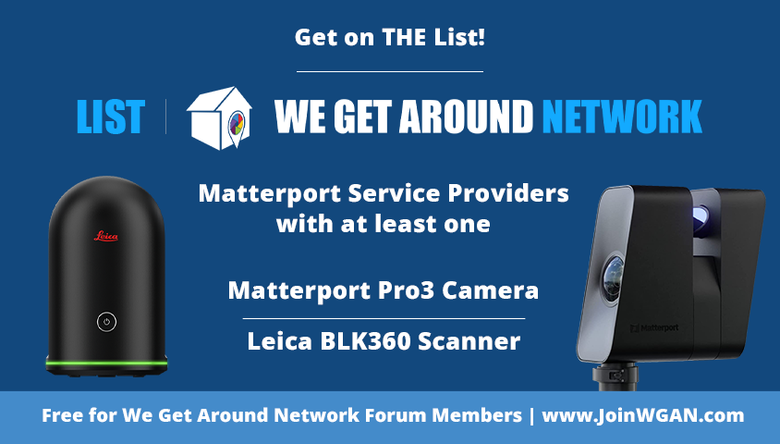 Join the WGAN List | Join WGAN Forum 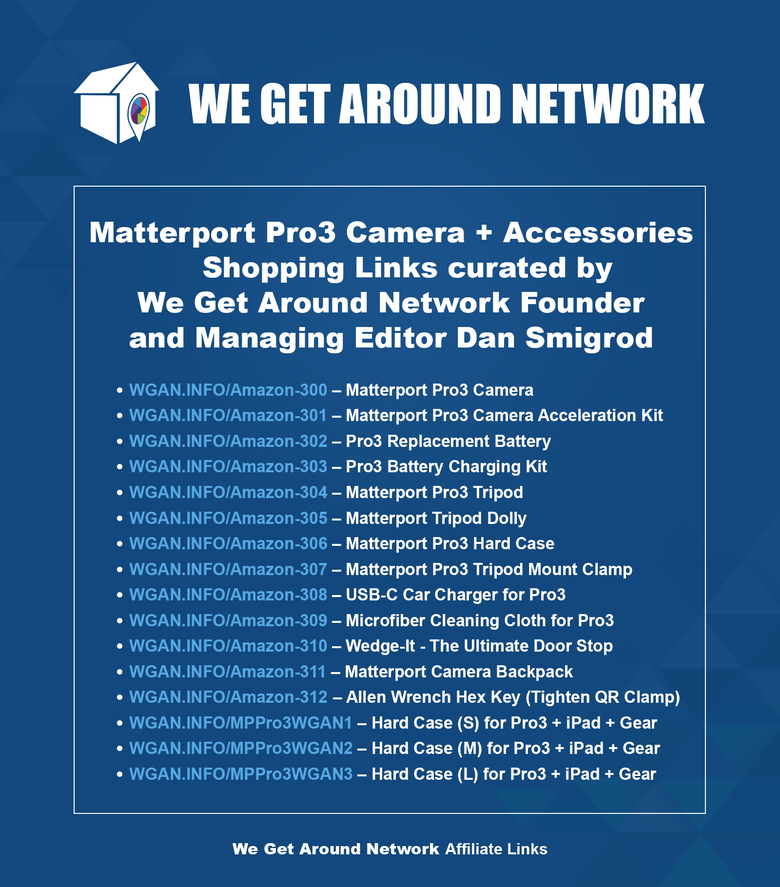 Matterport Pro3 Camera | Matterport Pro3 Camera Acceleration Kit WGAN Free Resources for Matterport Pro3 Camera: WGAN Forum | Pro3 Topics wgan.info/pro3topics WGAN-TV Podcast | Pro3 Shows wgan.info/pro3podcasts WGAN Forum Podcast | Pro3 Shows wgan.info/pro3audiopodcasts WGAN Pro3 Cost Worksheet wgan.info/pro3costworksheet WGAN Text Alerts | Pro3 News wgan.info/pro3alerts WGAN-TV Training U | Pro3 Courses |
||
| Post 1 • IP flag post | ||
 WGAN Forum WGAN ForumFounder & WGAN-TV Podcast Host Atlanta, Georgia |
DanSmigrod private msg quote post Address this user | |
| WGAN-TV | Tom Sparks (Sparks Media Group): “What I Learned from Using a Matterport Pro3 Camera to Scan a Baseball Stadium” | Guest: Scan Your Space (a Division of Sparks Media Group) Founder and CEO Tom Sparks | Episode: 183 | Thursday, 30 March 2023 | www.ScanYourSpace.com | www.SparksMediaGroup.com | @ScanYourSpace Transcript (video above) [00:00:02] Dan Smigrod: What are some of the possible uses of a Matterport digital twin of a baseball stadium? If you 'pitch' a baseball park, what are some of the ways that you might charge? What are some of the hardest things about scanning a baseball stadium? Stay tuned. Hi, all. I'm Dan Smigrod, Founder of the [www.WeGetAroundNetworkForum.com] Today is Thursday, March 30, 2023, and you're watching WGAN-TV Live at 5. We have an awesome show for you today: What I Learned from Using a Matterport Pro3 Camera to Scan a Baseball Stadium and here to talk to us about that is Scan Your Space Founder and CEO Tom Sparks. Tom, thanks for being on the show again. [00:00:53] Tom Sparks: 'Batter up.' [00:00:54] Dan Smigrod: Batter up. Ready to pitch. We're off to the races. I guess that's a different one. Tom, you're the Founder of Sparks Media Group. Scan Your Space is a division of Sparks Media Group. Before we jump into today's topic, how about telling us about your two companies? [00:01:14] Tom Sparks: Sure. Well, thanks for having me back. Sparks Media Group is the residential side of the house. We provide photos, video, floor plans, 3D tours for the residential real estate market. Scan Your Space covers the entire commercial, hospitality, and industrial side of the house where we provide photos, aerial, 3D tours, LiDAR scanning of commercial spaces. [00:01:44] Dan Smigrod: You're in Suisun City, California between San Francisco and Sacramento, but your coverage area is far beyond that. Can you fill us in on that? [00:01:56] Tom Sparks: We're covering all of California. We're covering Las Vegas. We're covering parts of Arizona. We're covering New Mexico and parts of Texas, and I'm trying to expand outward and take over the world. [00:02:12] Dan Smigrod: Sounds great. You can check out Tom's websites at: www.SparksMediaGroup.com and www.ScanYourSpace.com I reached out to Tom because he was in the midst of scanning this huge baseball stadium. Tom, why don't you jump in? Tell us what was the scope of the project? [00:02:36] Tom Sparks: Behind me, you can see is one of the images I took on, one of the days scanning at the [Oracle] ballpark. The scope, I was hired to capture a data file of the ballpark, that was one of the use-cases that took the majority of the time. We use the Matterport Pro3 Camera mostly, or I use the Matterport Pro3 Camera mostly. I provided 17 separate tours of the various areas. It was a total of 940 scans or so. We use the Matterport Pro2 Camera to provide about eight different tour links of most of the inside spaces, and that was about 155 or so scans. It took three days, I want to say. The first two days were about five, maybe a little more than five miles walked each day. Many, many floors climbed according to the Apple watch. The third day was about the same, five miles walked, more stairs climbed, and I had a second photographer there helping me out with some of the inside spaces with the Matterport Pro2 Camera. All in all, it was, for me, seven hours each day, three days, and then I had one of my other photographers there for about four hours doing the Matterport Pro2 Camera work. [00:04:04] Dan Smigrod: Sounds like a 'walk in the park.' If I did my math right, you delivered 25 Matterport tours that totaled 1,100 scans between the Matterport Pro3 Camera, Matterport Pro2 Camera, walked 15 miles, took nearly 24 hours, probably 24 hours if you include the additional team member. Did you scan the entire stadium? [00:04:51] Tom Sparks: We did 70% of it. We didn't have to do the boiler rooms, or the mechanical rooms, or anything like that. We did about 70% I'd say. I forgot to leave out one of the bigger numbers . By our estimations, it was over 400,000 square feet in total space that we scanned. [00:05:15] Dan Smigrod: Of the 400,000 square feet, I believe you scanned all the seats, the concourses, lounges, at least one of the restaurants, some of the suites. I'm I leaving anything out? [00:05:27] Tom Sparks: No. That was it. [00:05:29] Dan Smigrod: You didn't scan the diamond itself. [00:05:32] Tom Sparks: No, we did do the outfield. They were doing a lot of work in the infield, the diamond area, and they're very particular about keeping people off that when they're doing work, so they kept this off it. [00:05:45] Dan Smigrod: Just for clarification, this is the Oracle Park Stadium in San Francisco that's right behind you. [00:05:52] Tom Sparks: Correct, for the Giants. [00:05:55] Dan Smigrod: Awesome. Anything else in terms of the scale and scope of which you actually scanned? [00:06:06] Tom Sparks: No. I think that covered it. [00:06:10] Dan Smigrod: Awesome. Let's move into what did you learn from walking 15 miles, scanning for almost 24 hours, delivering 25 tours, nearly 1,100 scans? You had prepped me with some of your learnings, so let me see if I can prompt you with some keywords and see if I can have you rift a little bit. 1. "Start low." [00:06:41] Tom Sparks: Start low. I'm a firm believer that the Matterport Pro3 Camera can see better going up [stairs] than it came going down. If you start low on the field, you'll get a lot more usable data as you go up. Kind of like trailing data or leading data as you go up, which should help with alignment issues and possibly even coverage. I might be able to scan further apart and save the number of scanned points. I would have preferred to have started low. In this case, the first day, I had to start as high as the ballpark was and work my way down, and the second day, I started low and worked my way back up to the meeting point. [00:07:22] Dan Smigrod: Why is that? Why couldn't you just start low if that's what you're thinking was? [00:07:27] Tom Sparks: They had some field access issues or limitations on the first day, so they didn't want anybody on the field at all, and that's why I started. [00:07:37] Dan Smigrod: But in a perfect world, you'd start low and work your way up and probably have a better scanning experience. 2. "Plan your route." [00:07:50] Tom Sparks: Providing good 3D tours, whether it's just for a data file, or for marketing purposes, or whatever the use-cases, I prefer to have connected spaces: as few tours as possible. By planning a route ahead of time, you can see where those connection points are, whether it's a pedestrian ramp or an escalator. Where are the elevators to avoid because you can't scan in an elevator. Planning a route, seeing how you're going to go about doing things, how you're going to move. [00:08:24] Dan Smigrod: Did you do a walk-through days prior to scanning? Did you do that as the first thing that you did when you showed up? Did you look at floor plans before you began? What was your approach? [00:08:38] Tom Sparks: I had some aerial images and a few inside-the-park aerial images that were provided to me by the client that had a preferred path that they would have liked me to take in scanning. It helped as a general guide, but it wasn't really useful. It wasn't reality. They had scanned points every 50 feet apart in rows, so many rows apart and that wasn't what I experienced when I was there, so I threw that out the window. But no, I wasn't able to get in ahead of time and pre-plan it, I would have liked to, so that's something that I'm adding to my list for future projects. [00:09:18] Dan Smigrod: 3. You mentioned elevators. Elevators, escalators, can you talk a little bit more about that? [00:09:25] Tom Sparks: Stadiums are huge and there's multi-levels, and there's some areas where just elevators can access, so those had to be separate tours. There are some areas where there's escalators, but escalators will go from the first level to the third and skip the entire second level. [00:09:55] Dan Smigrod: You're talking about different levels, you can't get there from here unless you're on an elevator. Did that essentially define, well, "that's going to be a separate tour because I can't go up, I can't go down?" [00:10:12] Tom Sparks: Just knowing what those access points are and whether you're starting on the first level and you need to get to the second, before the third, just knowing what those levels are and where the points are is useful. [00:10:27] Dan Smigrod: 4. Keeping a pattern. [00:10:32] Tom Sparks: That's helpful just for the OCD aspect of seeing the scan points on the mini-map, you want to have them nice and aligned and that sporadically all over the place. I tried to do that as much as possible, whether it was within aisle-ways or number of rows, keeping them as uniform and tight as possible was good. [00:11:02] Dan Smigrod: 5. Mini-map. [00:11:07] Tom Sparks: What I've experienced with the Matterport Pro3 Camera is that the mini-map shows your coverage points, but it leaves out a lot that the camera is actually capturing. So when the tour is processed, you have a lot more filled in data. I guess that could be a good thing because if you're ensuring that the mini-map is completely filled in, then you're bound to have plenty of overlap and plenty of extra data you don't need. It could be a bad thing if you rely on that difference and you say, "Oh, well, I can see that I got somewhat coverage here and then somewhat coverage there. So I should be good," then you may end up missing something when it's actually processed. But for the most part, the mini-map doesn't show all of what's actually going to be processed. [00:11:55] Dan Smigrod: You actually got more, not less. More scanned data than less. Maybe in the field, since you didn't scan the diamond, was that a clue that you could see, "Oh, this is where the left fielder would normally stand. That's as far as I was allowed to scan." "Oh, I could see all the way in another 40 yards." [00:12:20] Tom Sparks: Right. I was doing the outside of the field area and I said, "Oh, I didn't get that far in at all." By the time the tour was actually processed, I surprisingly did get a lot more than I expected. [00:12:37] Dan Smigrod: 6. Alignment errors. [00:12:40] Tom Sparks: I got alignment errors, misalignments in areas where I didn't think that I would have them. I'm expecting alignment errors when something straight and all the seats look the same, and I wasn't necessarily getting them there. I was getting them around the curved part of the stadium behind home plate, but up high. It would put the scan points that I just scanned in a place where I previously was. I had to use the alignment tool in the Matterport app and I used it I think about 20-ish times, give or take, and it worked all but maybe three. So I was pleasantly happy about that. It kind of saved me. [00:13:32] Dan Smigrod: What does "it didn't work" mean? [00:13:35] Tom Sparks: It failed to align with where I wanted to put it. So I would realign it where it should have been, and then it wouldn't do it. [00:13:46] Dan Smigrod: This is almost 1,100 scans. Does this mean you literally looked at every scan point on your mini-map to make sure that it was where you expected it? [00:13:57] Tom Sparks: Yeah. Well, with the Matterport Pro3 Camera, it was 940 scans. Yeah, I looked at every single one of them. [00:14:09] Dan Smigrod: I'm guessing that after you processed 25 different Matterport tours, that you were somewhat pleased because you didn't have misalignment errors that would create problems for you when the tours were processed. [00:14:28] Tom Sparks: Correct. [00:14:32] Dan Smigrod: 7. Trim as you go. [00:14:36] Tom Sparks: That's a good rule of thumb. Whether you're doing a mobile home or this baseball stadium, you're there, you can see where mirrors are, you can see where windows are, you can see where the splatter that you want to cut out is. So it's just good to trim as you go. It adds a little bit of time to the project, but I think it's invaluable because you'll spend more time in front of the computer or more time at your office looking at these mini-maps, trying to trim it, and that's just tedious and painful. [00:15:09] Dan Smigrod: Did you run into a lot of mirrors? [00:15:12] Tom Sparks: Not a lot of mirrors, but there were a ton of windows in the suite areas. [00:15:23] Dan Smigrod: 8. Bring supporting accessories. [00:15:27] Tom Sparks: Yeah. One of the first things I learned was, I have a lot of family in the medical field and I should have talked to the doctors and nurses in the family to find out what kind of shoes they wear because the shoes that I had weren't. But yeah, supporting accessories. So battery packs, charging cables for the battery packs. I bought a couple larger battery packs that I'm super happy with. The video that I released, I'll put links to those products in there. But yeah, battery packs, charging cables, make sure you have extra batteries, make sure batteries are charged. I had an extra tablet on standby if I needed it. Then it can get down to everything such as layers of clothes. It was freezing the first day I was there, but the second day it was warmer out. Layers of clothes, headwear to keep your head not sunburned and warm. Snacks. I left all my stuff in one area, and by the time I ended up in the other area it was so far away. I was lucky to have some snacks on me. Water, bring plenty of water. [00:16:46] Dan Smigrod: I'm confused. You're in a baseball stadium, no concessions? [00:16:50] Tom Sparks: Yeah, I was just about to say that. I was like, "Great. I'm going to get to have a chocolate malt and hot dogs, and it's going to be great," and I got there and there's nobody working there. It's not a baseball day, so they didn't have any food. What I had to do the first day was, well, actually, on the second day, too, I DoorDashed and just met the DoorDash driver right outside the stadium and got my food and went and ate it. [00:17:19] Dan Smigrod: Was there anything else that you went, "Oh, forgot to bring that. Wish I had that with me"? [00:17:28] Tom Sparks: Not really, I made the mistake. My tablet has a neck strap, whatever you want to call it, strap. I made the mistake of trying to move the strap from one corner of the iPad to the other and I didn't have the stupid little tool that gets that thin piece of string under the loop, I don't know what it's called, but anyway. I had to hand-hold the tablet the whole first day and that was annoying. Just make sure your equipment is all good to go before you get on site. [00:17:58] Dan Smigrod: Sounds like you might be creating a checklist for the next stadium that you do. [00:18:02] Tom Sparks: Yeah, that's a good thing to have. [00:18:06] Dan Smigrod: You mentioned that you were going to share a video and publish it, so let's talk about that just for a moment. First of all, you often publish to the We Get Around Network Forum, so we went ahead and created a special tag for you: Sparks Media Group. The short link to get there is: www.WGAN.INFO/SparksMediaGroup Talk about the video that you're going to publish in the We Get Around Network Forum. [00:18:37] Tom Sparks: I made a video and the video is entitled: Matterport Pro3 Scan of a Baseball Stadium - Tips and use-cases for Why a Stadium Should Be Scanned. I didn't touch specifically on a walk-through on why I did this. I didn't do a walk-through video like I normally would. But I did talk about the project, in general, and then I talked about a ton of use-cases on why you would want to scan a stadium. So that's the video I'm going to put out after we're done today. [00:19:09] Dan Smigrod: There's two places you can find that video. First of all, at We Get Around Network Forum (www.WGANForum.com) or go right to the short link for all of Tom's content: www.WGAN.INFO/SparksMediaGroup You'll also be able to find it on Tom's YouTube channel: @Sparks Media Group You were kind enough to share that video with me prior to today's show. I'm going to refer to it in a moment to ask you some more questions. But before I did that, obviously, this was a massive project and even the thought of doing this, it was like, "Oh my gosh! how do I charge for this?" So how did you charge for this? [00:19:55] Tom Sparks: This was a unique situation for me because: houses I charge by the square foot. Warehouses I charge by the square foot. The client found me through my YouTube channel and he started off the conversation with, "Are you a sports fan?" I said, "Yeah. Go Warriors. Go Giants. Go 49ers." He goes, "Well, that's great. We have a project at the ballpark the Giants play at," and right there I was in! Sign me up. He said, "How do you charge for this?" I said, "Well, normally by the square foot. How many square feet do we need to scan?" He says, "I have no idea. It could be 200,000 square feet. It could be a million square feet." So I knew that that wasn't going to work. So we came up with a day rate. I charged this particular project on a day rate. [00:20:50] Dan Smigrod: Now that you've done all this scanning: three days, 15 miles, 25 Matterport tours, 1,100 scans, multiple pieces of equipment, and additional person helping you. Are you still happy that you charged a day rate? [00:21:11] Tom Sparks: I think I would charge a day rate. I would adjust it now that I understand the amount of work that's involved in it, and I might have a caveat of if it goes over a certain amount of square footage, it's going to be X amount more. Because ultimately, if I'm going to provide a BIM file, or a floor plan, or even just a rough square footage of what I scanned, those are always charged by the square foot for the most part. I think I would do a day rate plus a caveat of if it goes over this amount of square feet, this is what it's going to be. [00:21:55] Dan Smigrod: use-cases. Now, I can imagine the client engaged you for one particular use-case, but I can also imagine why you're scanning for three days - times seven hours a day - you're thinking, "Well, gee, I wonder what else this baseball stadium could be used for?" [00:22:47] Dan Smigrod: You sent me a list ahead of time. I want to prompt you from your list and just ask you to expand on that. Architects. Engineers. Construction: AEC. [00:23:05] Tom Sparks: This ballpark is 23-years-old. They didn't have any data files that they could provide me or my client, whether that was blueprints, floor plans, they didn't have anything. That right there is a use-case: an as-built scan of the ballpark is helpful for anything related to remodels, construction, all that sort of thing. Actually, while I was there, they had contractors doing work there. It seems to be the space that's updated pretty frequently. That's a huge use-case right away is just having an as-built scan of the ballpark for current needs. [00:23:50] Dan Smigrod: Anything else on AEC related? [00:23:55] Tom Sparks: That was the most important part of it. [00:24:02] Dan Smigrod: 2. Training? [00:24:05] Tom Sparks: The staff was super-friendly, but a lot of the people that were showing me around were probably used to sitting in an office in front of a computer. They weren't necessarily familiar with all the areas that I needed to scan. I think for training purposes, if you're bringing on new staff, you could provide them a 3D tour of the ballpark and say, "here's the ballpark, here's this lounge, here's this suite" and they can familiarize themselves with the park via the 3D tour. [00:24:42] Dan Smigrod: 3. Facilities management. [00:24:44] Tom Sparks: That's a big one. I didn't get to see all the areas, but as I was walking through, I noticed the generator room, I noticed the electrical room, the boilers and stuff like that. Imagine being able to tag all those assets with make and model and serial number. There's a lot of devices that are Internet of Things (IoT) devices where you can get real-time data from temperature sensors and all that. We can scan the ballpark and embed those links on the 3D tour. It would help if a generator went out, you would know where it is based on the scan. You can measure flooring, you can measure walls, you can measure windows if things ever need to be painted or replaced, count light fixtures. [00:25:36] Dan Smigrod: 4. Vendor use, what does that mean? [00:25:39] Tom Sparks: I put vendor use, me when it was time for lunch break, I had to remember how to get back down to my car. I was fortunate enough to be able to park inside the stadium, but it was like a mouse in a maze. I ended up in some weird places. To be able to provide a 3D tour and say, "okay, here's where you're going to start and here's where you're going to be working and that's the path stick to it," so I don't end up in the vice president's office of baseball operations or the announcements booth. [00:26:19] Dan Smigrod: 5. Insurance. [00:26:22] Tom Sparks: Risk assessment, claims management, that sort of thing. You scan the ballpark and you have an accurate documentation of what's in there. If there's ever a loss, whether that's an earthquake, we're in the Bay Area, or if there's a fire or a flood, you have that documentation of what was at the park at the time prior to the loss. [00:26:45] Dan Smigrod: 6. Marketing and promotion. [00:26:48] Tom Sparks: Well, this ballpark has been rented out for private events. I actually did photography for a bacon event there one time. Kanye West rented it out to propose to Kim Kardashian. There's things where if it's being rented out, somebody may want to know the size of a room so they can plan decorations ahead of time. It's good in that aspect. There's some fans, for example, who aren't able to get to a stadium to enjoy a game, but they want us to experience what it's like being in the ballpark. I have a friend who had a stroke and he's not as mobile as he used to be, but he wants to go to the LA Rams game. If I stayed in, I think it's really nice. Imagine being able to scan that and send him a link and he can go explore it on his own. And then when he's watching the game on TV, he can feel like he's been there. Those are some key aspects I liked about it. [00:27:50] Dan Smigrod: Other marketing and promotion use-cases? [00:27:57] Tom Sparks: Ticket sales. There's companies that can provide simulated views of what seat a fan would buy. A fan buys a seat, they want to know what view they're going to get at the field. There's companies out there that can take the scan data and provide that render, I guess is what you want to call it. [00:28:23] Dan Smigrod: I think you scan some suites. I would imagine it's a similar thing if you're going to go buy or lease or rent or however that works, you want to know what your suite looks like before you get there. [00:28:36] Tom Sparks: Yeah. I heard on the news yesterday that Levi's Stadium where the San Francisco 49ers play, they're going to borrow $120 million to add a bunch of seats, but also I think nine new suites. Imagine being able to scan the existing suites and maybe even using some of that data to render what views would look like of the new suites. Then you could get that out to the public so that borrowing money would be a little easier. [00:29:05] Dan Smigrod: 7. Your notes to me, you talked about historic preservation, do you want to comment on that? [00:29:10] Tom Sparks: Yeah. I think a lot of the ballparks are fairly new, but some of the older ones, being able to go in and scan what the ballpark looks like for historical purposes. When they are demolished, you have that record of, "this is how it used to look back in the day." Imagine seeing what the Roman Colosseum looks like intact now it'd be huge. [00:29:33] Dan Smigrod: Did they do a Matterport scan back when they built it? ;-) [00:29:37] Tom Sparks: The Roman Colosseum? [00:29:39] Dan Smigrod: Yes. ;-) [00:29:40] Tom Sparks: Could they have? I don't know. Maybe. They built pyramids, before they had a lot of technology, so who knows? [00:29:49] Dan Smigrod: 8. Emergency preparedness? [00:29:53] Tom Sparks: Yeah, when I hear that I immediately think about the unfortunate school shootings that happened. But it could also carry over to any public venue. There was back in 1989, the Battle of the Bay where the Giants were playing the Oakland As and the earthquake happened out here: the Loma Prieta earthquake. I don't know if you've ever been in an earthquake, but what they teach you in school versus what happens in reality is completely different. They teach you; get in a doorway, but when the earthquake happens, you freeze and you don't know what to do. Going back to emergency preparedness, having a scan of a ballpark would be huge in helping first responders. If an area collapsed, they could see what the structure looked like before the collapse. If there was a shooting situation or whatever it is, they could know the quickest route to get there. Evacuation routes if there's a fire and you can plan the quickest way to get out. That may be different than what was drafted originally because the park had changed so much. [00:31:10] Dan Smigrod: 9. We went through [eight] categories of use-cases. Was there anything else that you thought about? Overall categories while you're walking around, "oh, this would be great for this use or that use." [00:31:29] Tom Sparks: I was thinking about customer service. Going to the mall back in the day and you're asking, "where is the hot dog on a stick?" and the person at the information counter doesn't eat hotdogs, so they don't want to tell you how to get there. But it would be good for customer service, people at the park who may not travel around the park that much to be able to know where things are or at least have a general idea. [00:31:56] Dan Smigrod: Well, that'd be Matterport MatterTag worthy: hot dog on a stick concession. ;-) [00:32:00] Tom Sparks: Yeah. I was at the Chase Center watching a Golden State Warriors game and my wife wanted a churro and I thought, "they should have a churro around here." I went to five different people and nobody knew. Some random janitor said, "Oh yeah. the churros are in the bar that you can't access because you didn't buy the good seats." ;-) It'd be nice to have that information without having to miss half of the game. [00:32:27] Dan Smigrod: Let me ask you some random questions. You use the Matterport Pro3 Camera and a Matterport Pro2 Camera. You bought the Matterport Pro3 Camera. Why did you add Matterport Pro2 Camera scans? [00:32:42] Tom Sparks: Mainly because my photographer had a Matterport Pro2 Camera. I only had one Matterport Pro3 Camera available at the time. It was inside spaces, so we didn't really need a Matterport Pro3 Camera inside. [00:32:57] Dan Smigrod: It wasn't that there was some capability of the Matterport Pro2 Camera. That enabled you to double up and have two Matterport Service Providers creating content simultaneously? [00:33:09] Tom Sparks: Correct. [00:33:12] Dan Smigrod: Did you get any feedback from your client? [00:33:17] Tom Sparks: They hadn't done a space this large, so they were expecting it to be a little quicker than it was. I think tooting my own horn that I'm one of the most efficient people I know at scanning just by the way that I think and how long I've been doing it. [00:33:41] Tom Sparks: But once I explained it to them and showed them the data, they were totally blown away with it. The amount that I was able to capture, the detail that the Matterport Pro3 Camera captured. They were happy with it. [00:33:57] Dan Smigrod: Overall were you happy that you had the Matterport Pro3 Camera; hasn't been out all that long? Could you have done this project without it? Were you happy with it? [00:34:07] Tom Sparks: I was happy with it. Actually, I took a BLK360, the first version there, and did literally three scans and I put it back in the case. [00:34:20] Dan Smigrod: That's the Leica BLK360 1st generation scanner - works with Matterport. Why did you put it back in the case? Did you just decide it was going to take forever and a day? [00:34:30] Tom Sparks: That's it. Was like four minutes to scan. [00:34:34] Dan Smigrod: This is not going to work. ;-) [00:34:37] Tom Sparks: Even with that, there were some alignment issues. With the Matterport Pro3 Camera, if you're going to get an alignment issue, or even with the Matterport Pro2 Camera, you're going to get it within 45 seconds, 50 seconds - total - from start to finish. With the Leica BLK360 1st generation, you have to wait four minutes to find out there's an alignment issue. You're like, "man!" [00:35:01] Dan Smigrod: Do you recall what setting you had it on? Was it on ...? [00:35:07] Tom Sparks: It was on medium density. I wanted to try to keep it as apples to apples with the Matterport Pro3 Camera, as I could. [00:35:16] Dan Smigrod: Is there anything that you could have accomplished with the Leica BLK360 that you couldn't do with the Matterport Pro3 Camera? I'm looking at the stadium behind you. There's some overhang. Was there a point where you were in the seats that are below - I don't know what you call that - but you're in the seats below the overhang, did the Matterport Pro3 Camera capture the ceiling or it was irrelevant for your client? Anyway, it didn't matter. [00:35:47] Tom Sparks: The Matterport Pro3 Camera did capture the overhang. That wasn't a huge issue. I just think with the Matterport Pro3 Camera out, it's for me as a first-generation Leica BLK360 killer. I hear that the second generation is much quicker. That may be a good video. Second-generation BLK360 versus the Matterport Pro3 Camera. [00:36:12] Dan Smigrod: Matterport has announced that they will support the Leica BLK360 second generation scanner, but as far as I know, they haven't put a date to that. Just, "yes, we're going to support it." [00:36:26] Dan Smigrod: Was there anything else where when you think about the scanning experience that you would have approached this project differently? [00:36:41] Tom Sparks: Aside from just starting at the field and working my way up. No, I think I did it. Luckily, I have enough experience again to totally tooting my own horn. I have enough experience where I wasn't questioning, "how to do this" or "which way is the best method?" I knew what to do. For the best results, there was one area towards right field in the upper reserve that I didn't scan due to timing limitations on the first day. The first day I did the whole upper reserve area and I had a hard stop because the escort that was showing me around that day, she had to leave and it was seven hours that day. I didn't get to finish, but the client said that that was okay. They had enough data where I was at. They didn't need that. But now that I look back at the model, "I wish I would've been able to finish that." At some point, if I'm lucky enough to get back there, I'm going to scan that upper reserve area. [00:37:52] Dan Smigrod: I think I would say this. You've been on WGAN-TV three previous times, two of them: 1) 10 Pro Tips for Scanning with the Matterport Pro3 Camera. The other was 2) When and Why I use a Matterport Pro3 Camera (and even other cameras). You've obviously been doing this a long time. You've done other super-large spaces, large projects. You've now accomplished this. I can imagine that there are some Matterport Service Providers that are watching the show thinking, "Oh! I have a baseball park in my hometown. There's [nine] different use-cases." [00:38:40] Dan Smigrod: Can you help them? How do you help them? How might you be involved with their project? [00:38:46] Tom Sparks: I've actually talked to a few people that have reached out via Facebook, reached out via [www.WGANForum.com], via private Messenger, and just said, "hey, I saw that you were working on this. Can you provide some feedback?" I'm happy to hop on calls and maybe charge a small consultation fee for that. But I'm happy to give any advice I can. [00:39:09] Dan Smigrod: Is it the thing they might be able to partner with you? Subcontract work to engage you? Bring you in? I can imagine: "I'm in a local market and I have relationships, trusted relationships. But the thought of going to scan, three full days, five full days of a stadium might actually be totally overwhelming." You don't know what you don't know, and then you get into a problem. Now, you've committed to a very large project and you're stuck and you can't deliver it. Are you thinking about that at all, that there might be Matterport Service Providers that actually just bring in Sparks Media Group to subcontract the project with you or partner with you on the project? [00:39:55] Tom Sparks: Yes. I've offered B2B - business-to-business - pricing for other business owners; other MSPs who want to do it and they may have limitations. They may have a ton of work elsewhere that they just can't dedicate the time to. They may have health limitations. I'm not the most fit person that was a workout, walking up and down those stairs. I can imagine some people wouldn't want to do it. Mobility issues. I'm happy to help out where I can. [00:40:30] Dan Smigrod: Even in terms of just consulting to say, "this is what I've been asked to quote on." [00:40:40] Dan Smigrod: To be able to perhaps fill in some of the blanks of scale and scope, kinds of equipment, kinds of questions to ask the client, trying to understand use-cases, etc. [00:40:52] Tom Sparks: Understanding the use-cases. A huge part of it. Knowing exactly what they want it for. [00:41:01] Dan Smigrod: In fact, did that affect how you scanned because I did note in your video, I think you talked about; you did every 10 paces. You took 10 steps to scan. [00:41:13] Tom Sparks: Yes. [00:41:14] Dan Smigrod: Would you have done this differently if it was going to be used in different ways? Meaning you might have had the scans closer together or you might have had the scans farther apart? [00:41:50] Tom Sparks: Yah, the construction file needs specific scan points in certain areas versus if you're doing it for marketing purposes, you may want to show right in front of the particular restaurant, so you can see the menu. You don't necessarily need that information for an as-built file, so that would affect - knowing the use-case and what they're going to use it for, would impact how I'm going to scan. Some clients have a mentality of, "one-size-fits-all. We'll have you scan the park and then we can use it for X, Y and Z." And it's not always that way. [00:42:33] Dan Smigrod: -Did your client engage you for, "I need the following spaces scanned and that might take 3, 5, 7, 10 days to do" or did they say, "hey, I will engage you for three days, get as much done as you can?" [00:42:49] Tom Sparks: -They had a list of spaces and they estimated it would take four days. They didn't have a problem if I went over that, but I don't like to waste time and/or money, so I was just knocking it out as I could. Knocking it out of the park! ;-) [00:43:11] Dan Smigrod: -Good job on that. You walked to about seven hour days, Did you literally take breaks? So you had lunch. We know you had DoorDash deliver at least two of those days. [00:43:32] Dan Smigrod: Do you build that into say, "I need to take breaks, otherwise, I'm going to kill myself doing this." [00:43:39] Tom Sparks: - I definitely took bathroom breaks. I took some breaks to go grab my water, I carry a big gallon of Crystal Geyser water around when I'm doing projects and I'd drink that throughout the day, so I took some water breaks and I took a lunch break and I don't think it was up to Cal/OSHA standards or whatever. The California Division of Labor Standards Enforcement, but definitely took a good 45 minutes out of the day to replenish myself. [00:44:14] Dan Smigrod: -Before we finish up here, is there anything that we haven't talked about - about what you learned from using a Matterport Pro3 Camera to scan a baseball stadium? Is there anything that says, "Oh! Gee. We should have talked about the following?" [00:44:35] Tom Sparks: -I can't think of anything. I think we covered a lot of it. [00:44:40] Dan Smigrod: -Let's talk about your blog post, your video, other things that you're going to share even beyond being on today's show. [00:44:48] Tom Sparks: -I made a video. I showed the mini-map of some of the scans that I did where you can see the scan patterns, and I talked about that a little bit. I showed a high-level overview of the actual tour. I didn't show the specific - I'm not going to share the tour link - or the actual tour, but I showed the dollhouse view of that, and then I went into detail about all the use-cases, so I think that's going to be super-helpful. I put all that together in a video and I'll release it when we're done with [WGAN-TV Live at 5] and then I have a blog post which is just a text version of the use-cases that I'll also put in the [www.WGANForum.com] as well, so that people can see that. Feel free to cut and paste it and use it for your own needs. [00:45:35] Dan Smigrod: -Awesome. If you want to see Tom's video, which is really awesome because I thought it was really helpful to take a look at your mini-maps, and you are very precise in terms of how you do the rows, the seats; they're straight lines. It's very organized and meticulous. Talking about planning your route. It looked like you'd had a mission and you stuck to it. You can see all these mini-maps, the tour within Tom's video. He will be posting it to the We Get Around Network Forum (www.WGAN forum.com). He mentioned his blog post. Tom will post that in We Get Around Network Forum, as well, really, just as soon as we finish up today, A quick short link to get to all of Tom's assets in the We Get Around Network Forum - all the content that he publishes: www.WGAN.INFO/SparksMediaGroup - You can search by tags in the [www.WGANForum.com] and there's a tag: Sparks Media Group Then I'd also encourage you to check out Tom's websites. He has two of them for his real estate photography business, www.SparksMediaGroup.com, and then one specific one we're scanning and that's: www.ScanYourSpace.com Again Tom is based in Suisun City, California, halfway between San Francisco and Sacramento. [00:47:15] Dan Smigrod: Tom you "hit it out of the park." ;-) [00:47:20] Tom Sparks: -Real quick, just the general rule. This doesn't have to apply to just stadiums. This could be arenas, this could be soccer fields, this could be convention centers, so take what we talk about and apply that to the large space that you have. [00:47:38] Dan Smigrod: -Thank you for bringing it up. I mean, part of the reason I invited you to be on the show is anytime someone does an incredibly huge project, there's so much learning that comes from that, and you've been very gracious to share with the community what you've learned, what problems you've had, what challenges you had even your strategy for pricing. I just think, this is a gift to the community for you to share what you learned from walking 15 miles, creating 25 Matterport tours, doing 1,100 scans of obviously an incredibly large space. I hope just for your personal gratification, get to go back to the stadium to fill in the diamond and the way-up in the corner, so you feel I really wanted to have a tour of the entire stadium. Even if you don't have a client that needs those two pieces. I feel your pain. You really wanted to have literally the entire ballpark. [00:48:49] Tom Sparks: I did. [00:48:54] Dan Smigrod: Tom, thanks for being on the show again. [00:48:56] Tom Sparks: Thanks for having me. I appreciate it. It's always a pleasure. [00:48:59] Dan Smigrod: Thank you. We've been visiting with Sparks Media Group Founder and CEO Tom Sparks. I'm Dan Smigrod, Founder of the We Get Around Network Forum, and you've been watching WGAN-TV Live at 5. |
||
| Post 2 • IP flag post | ||
Pages:
1This topic is archived. Start new topic?



